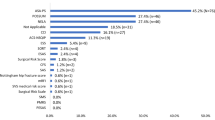Abstract
Objective:To determine the effects of age and work status on whether and where cardiovascular specialists would place hypothetical patients in the queue for coronary surgery.
Materials and methods:Mailed survey presenting a set of clinical scenarios either to be rated on a scale with 7 time frames for urgency of need or to be designated as questionable/inappropriate for intervention. The basic scenario was a patient with mild-moderate stable angina, good left ventricular function, and limited coronary disease; operative risks and stress test results were varied. Three identifiers were used: “45-year-old civil servant gainfully employed”; “45-year-old laborer disabled by angina, faces job loss”; and “75-year-old retiree, angina limits golf.”
Participants:Cardiologists and cardiac surgeons practicing in five Ontario medical centers (n=120).
Results:There was a 59% response rate (120 usable responses). Large shifts in willingness to intervene occurred in favor of the disabled laborer (p<0.0001) and against the retiree (p-value ranges from 0.04 to <0.0001, depending on operative risk and stress test results), but not for the employed civil servant. Striking effects (p<0.0001) were also evident in ratings of waiting time, with the order of priority being the disabled laborer first, the civil servant second, and the retiree last. The overall mean shift due to work status or age was equal to, or larger than, the mean shift due to clinical factors, such as stress test results, changes in severity of stable angina, and extent of coronary disease.
Conclusion:Cardiovascular specialists may place considerable weight on age and work status in determining urgency and appropriateness of coronary revascularization. Risk-benefit concerns may partly explain shifting thresholds for intervention, but not differential waiting times. The influence of these factors should be sought in utilization audits and addressed from an ethical perspective.
Similar content being viewed by others
References
Kaminski VL, Sibbald WJ, Davis EM. Investigation of cardiac surgery at St. Michael’s Hospital, Toronto, Ontario: final report (appendix 11). Mimeo, 15 February 1989:24–5.
Naylor CD, Baigrie RS, Goldman BS, Basinski A, Revascularization Panel, Consensus Methods Group. Assessment of priority for coronary revascularization procedures. Lancet. 1990;335:1070–3.
Naylor CD, Basinski A, Baigrie RS, Goldman BS, Lomas J. Placing patients in the queue for coronary revascularization: evidence for practice variations from an expert panel process. Am J Public Health. 1990;80:1246–52.
Brook RH, Chassin MR, Fink A, Solomon DH, Kosecoff J, Park RE. A method for the detailed assessment of the appropriateness of medical technologies. Int J Tech Assess Health Care. 1986;2:53–64.
Park RE, Fink A, Brook RH, et al. Physician ratings of appropriate indications for six medical and surgical procedures. Am J Public Health. 1986;76:766–72.
Chassin MR, Park RE, Fink A, et al. Indications for selected medical and surgical procedures—a literature review and ratings of appropriateness: coronary artery bypass graft surgery (RAND R-3204/2CWF/HF/PMT/RWJ). Santa Monica, CA: Rand Corporation, 1986.
Naylor CD. A different view of queues in Ontario. Health Aff (Millwood). 1991;10:110–28.
Naylor CD, Levinton CM, Baigrie RS. Adapting to waiting lists for coronary revascularization: do Canadian specialists agree on which patients come first? Chest. 1992;101:715–22.
Campeau L. Grading of angina pectoris [letter]. Circulation. 1976;54:522–3.
Morris AL, Roos LL, Brazauskas R, Bedard D. Managing scarce services. A waiting list approach to cardiac catheterization. Med Care. 1990;28:784–92.
Naylor CD, Linton AL. Allocation of health care resources: a challenge for the medical profession. Can Med Assoc J. 1986;134:333–40.
Aaron H, Schwartz WB. Rationing health care: the choice before us. Science. 1990;247:418–22.
American College of Physicians. Access to health care. Ann Intern Med. 1990;112:641–61.
Brook RH, Kosecoff JB, Park RE, Chassin MR, Winslow CM, Hampton JR. Diagnosis and treatment of coronary disease: comparison of doctors’ attitudes in the USA and the UK. Lancet. 1988;1:750–3.
Gray D, Hampton JR, Bernstein SJ, Kosecoff JB, Brook RH. An audit of coronary angiography and coronary artery bypass surgery in the Trent region based on ratings of appropriateness. Lancet. 1990;335:1317–20.
Author information
Authors and Affiliations
Rights and permissions
About this article
Cite this article
Naylor, C.D., Levinton, C.M., Baigrie, R.S. et al. Placing patients in the queue for coronary surgery. J Gen Intern Med 7, 492–498 (1992). https://doi.org/10.1007/BF02599450
Issue Date:
DOI: https://doi.org/10.1007/BF02599450




